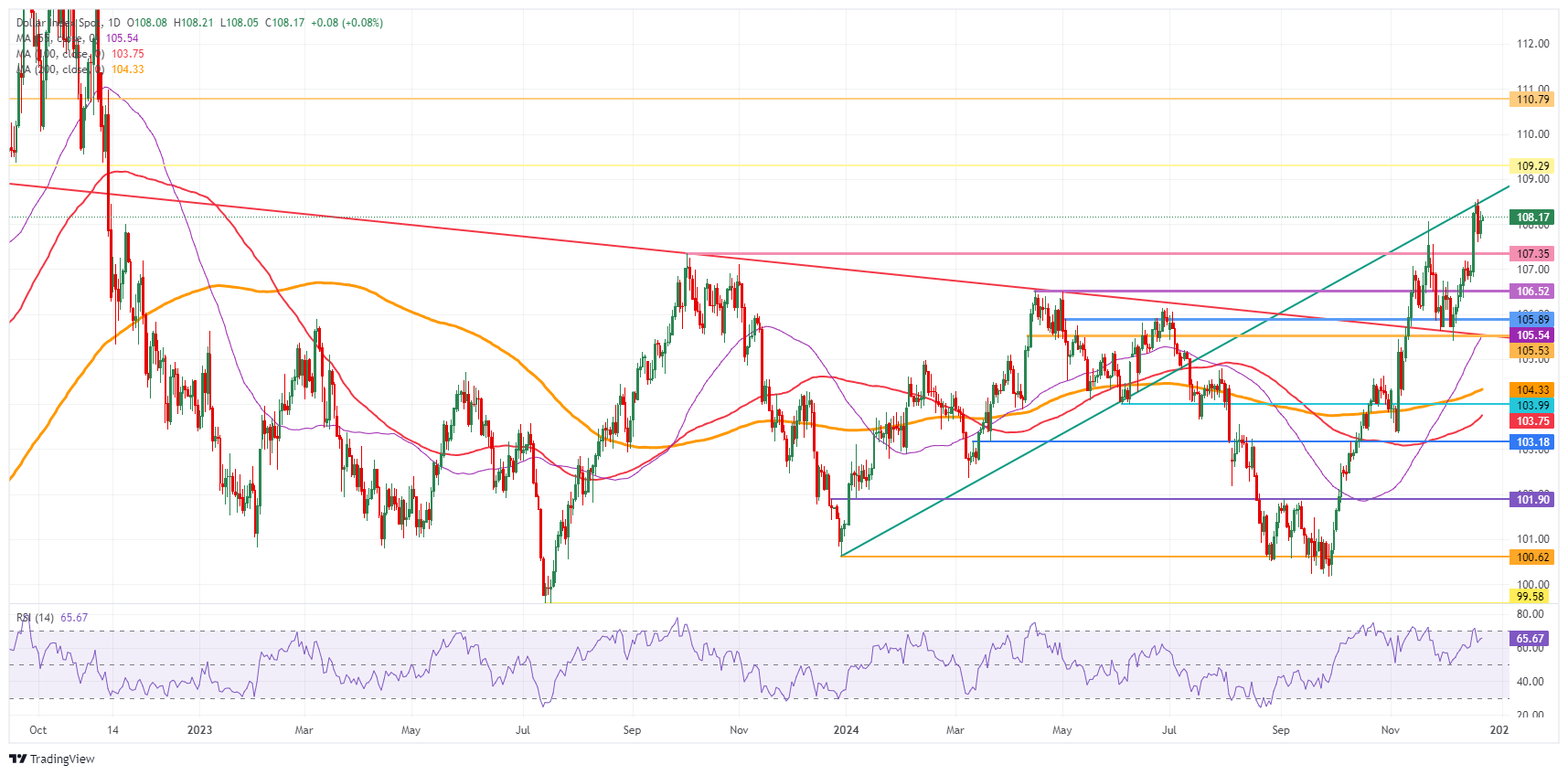- The US dollar remains broadly stable despite headlines from China about increased bond sales next year.
- China’s monetary policymakers plan to sell a record 3 trillion yuan of special treasury bonds in 2025, the highest on record.
- The US Dollar Index (DXY) is at 108.00, very close to hitting a new two-year high.
The US Dollar (USD) remains sideways on Tuesday, with the DXY Index slightly above 108.00, as markets begin to relax towards the Christmas holidays. The dollar failed to move significantly despite news that China’s monetary policymakers are considering the idea of selling nearly 3 trillion Yuan (CNH) in special treasury bonds in 2025, Reuters reported on Tuesday. The additional capital should boost China’s slowing and stagnating economy.
The US economic calendar is very light on Tuesday, with only minor indicators such as the Philadelphia Fed Non-Manufacturing Activity Index and the Richmond Fed Manufacturing Index regional surveys for December. A major takeaway from the latest December data is that the US manufacturing sector is sounding the alarm, with several indicators confirming that the sector is falling further into contraction.
Daily Market Summary: Light Participation
- China’s monetary policymakers plan to sell a record 3 trillion Yuan ($411 billion) in special treasury bonds in 2025, Reuters reported on Tuesday. The government is seeking to support consumer subsidies, business equipment upgrades, as well as investments in key technology and advanced manufacturing sectors, according to Reuters.
- French Prime Minister Francois Bayrou aims to reach a deal with parliament on a 2025 budget that would reduce the deficit to around 5%, close to the level of his predecessor Michel Barnier, Bloomberg reports.
- Around 13:30 GMT, the Philadelphia Fed Non-Manufacturing Activity Index for December is published. The previous reading was -5.9.
- At 15:00 GMT, the Richmond Fed Manufacturing Index is expected to remain in contraction at -9, coming from -14.
- Asian stocks are on the rise after China’s expected 3 trillion Yuan injection. Europe is struggling to benefit from that tailwind and continues to look sluggish. US futures are marginally in the green.
- The CME’s FedWatch tool for the first Fed meeting of 2025 on January 29 sees a 91.4% chance of a stable policy rate versus a slim 8.6% chance of a 25-point rate cut basics.
- The US 10-year benchmark rate is trading at 4.59%, last week’s high.
US Dollar Index Technical Analysis: Last Straw
The US Dollar Index (DXY) is trading in a fairly tight range this Tuesday. More and more traders will not participate in the markets today, which will mean almost no price reaction unless a big headline emerges. Therefore, it looks like the DXY is set to close on Christmas Eve very close to a two-year high.
To the upside, a trend line originating on December 28, 2023 is acting as a moving limit. The next firm resistance lies at 109.29, which was the July 14, 2022 peak, and has a good track record as a pivotal level. Once that level is broken, the round level of 110.00 comes into play.
The first barrier to the downside is at 107.35, which has now moved from resistance to support. The second level that could stop any selling pressure is 106.52. From there, even 105.53 could be considered as the 55-day SMA at 105.23 is rising towards that level.
US Dollar Index: Daily Chart
US Dollar FAQs
The United States Dollar (USD) is the official currency of the United States of America, and the “de facto” currency of a significant number of other countries where it is in circulation alongside local banknotes. According to 2022 data, it is the most traded currency in the world, with more than 88% of all global currency exchange operations, equivalent to an average of $6.6 trillion in daily transactions. After World War II, the USD took over from the pound sterling as the world’s reserve currency.
The single most important factor influencing the value of the US Dollar is monetary policy, which is determined by the Federal Reserve (Fed). The Fed has two mandates: achieve price stability (control inflation) and promote full employment. Your main tool to achieve these two objectives is to adjust interest rates. When prices rise too quickly and inflation exceeds the 2% target set by the Fed, the Fed raises rates, which favors the price of the dollar. When Inflation falls below 2% or the unemployment rate is too high, the Fed can lower interest rates, which weighs on the Dollar.
In extreme situations, the Federal Reserve can also print more dollars and enact quantitative easing (QE). QE is the process by which the Fed substantially increases the flow of credit into a clogged financial system. This is an unconventional policy measure used when credit has dried up because banks do not lend to each other (for fear of counterparty default). It is a last resort when a simple lowering of interest rates is unlikely to achieve the necessary result. It was the Fed’s weapon of choice to combat the credit crunch that occurred during the Great Financial Crisis of 2008. It involves the Fed printing more dollars and using them to buy US government bonds, primarily from financial institutions. QE usually leads to a weakening of the US Dollar.
Quantitative tightening (QT) is the reverse process by which the Federal Reserve stops purchasing bonds from financial institutions and does not reinvest the principal of maturing portfolio securities in new purchases. It is usually positive for the US dollar.
Source: Fx Street
I am Joshua Winder, a senior-level journalist and editor at World Stock Market. I specialize in covering news related to the stock market and economic trends. With more than 8 years of experience in this field, I have become an expert in financial reporting.








